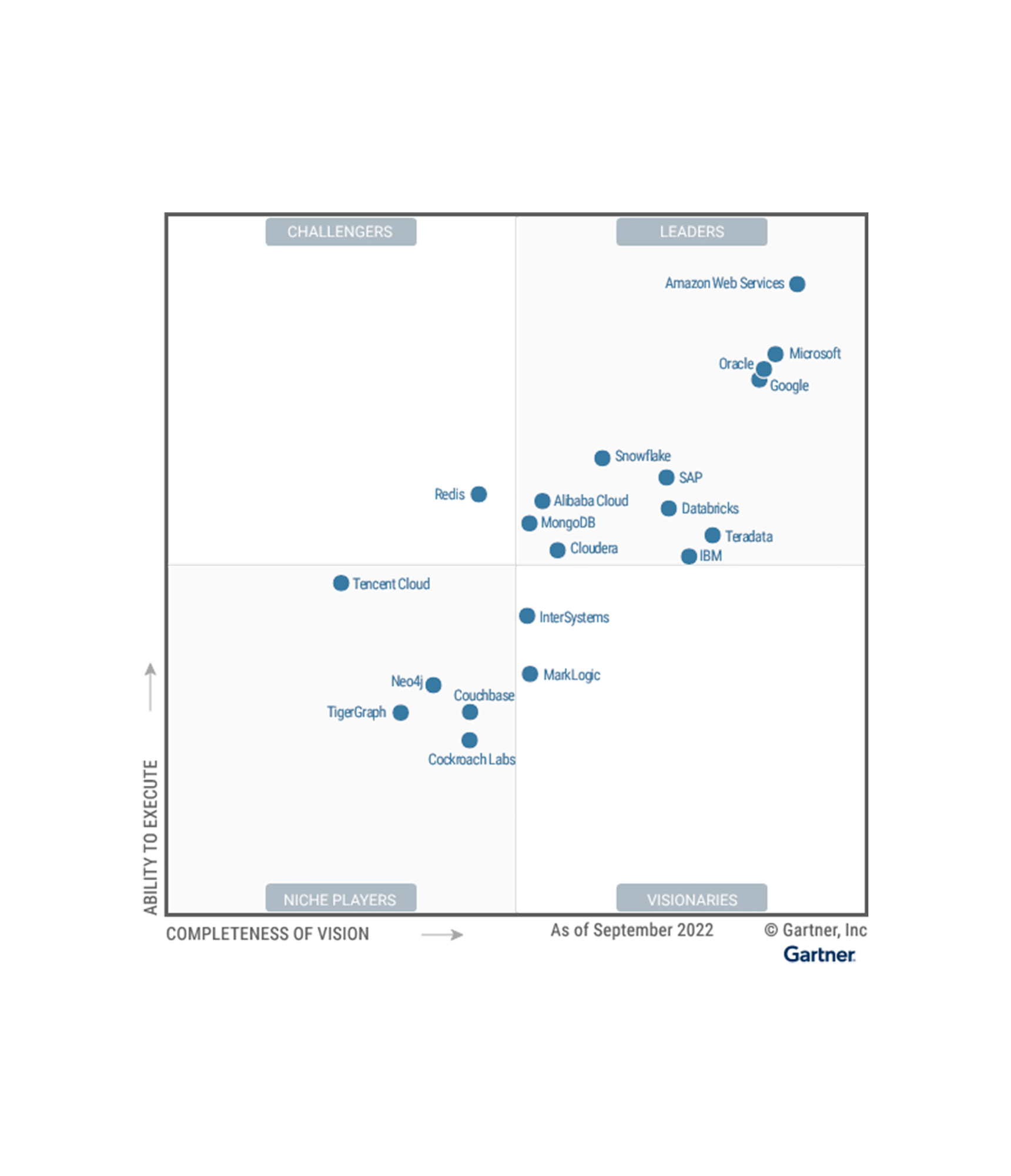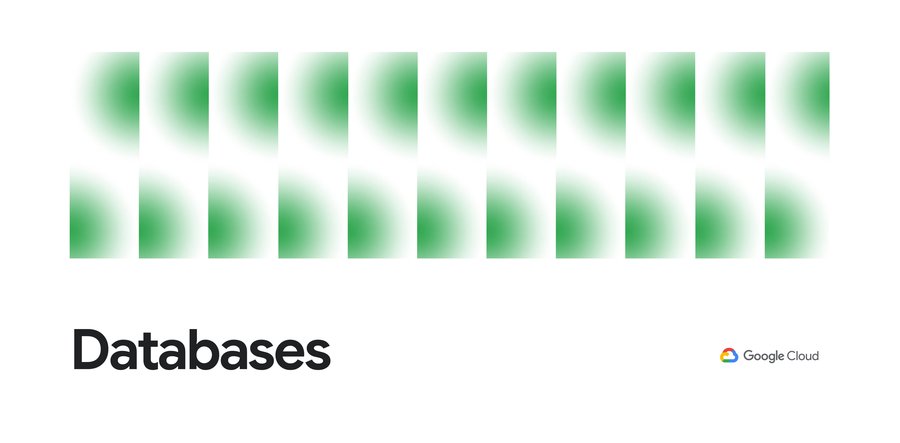Google named a Leader in 2022 Gartner® Magic Quadrant™ for Cloud Database Management Systems
Andi Gutmans
VP/GM, Data Cloud, Google Cloud
Gerrit Kazmaier
VP & GM of Data Analytics, Google Cloud
Try Google Cloud
Start building on Google Cloud with $300 in free credits and 20+ always free products.
Free trialWe’re excited to share that Gartner has recognized Google as a Leader in the 2022 Gartner® Magic Quadrant™ for Cloud Database Management Systems, for the third year in a row. We believe this recognition is a testimony to Google Cloud’s vision and strong track record of delivering continuous product innovation, especially in areas like open data ecosystems and unified data cloud offerings.


Download the complimentary 2022 Gartner Magic Quadrant for Cloud Database Management Systems report.
Modern applications need to support a large number of globally distributed users, with no downtime and fast performance. And, with the exponential growth in the amount and types of data, workloads, and users, it's becoming incredibly complex to harness data’s full potential.
This results in a growing data-to-value gap.
Google’s data cloud is well positioned to address the modern data needs of organizations with intelligent data and analytics services, advanced security, and a strong partner ecosystem, all integrated within a unified platform. We continue to rapidly innovate across these areas of the data space, especially with the new capabilities we announced at Google Cloud Next ’22 from our databases and data analytics portfolios.
Organizations such as Walmart, PayPal, and Carrefour, as well as tens of thousands of other customers around the world, have partnered with Google Cloud to drive innovation with a unified, open, and intelligent data ecosystem.
Unified data management
Google’s data cloud provides an open and unified data platform that allows organizations to manage every stage of the data lifecycle — from running operational databases for applications to managing analytical workloads across data warehouses and data lakes, to data-driven decision making, to AI and Machine Learning. The way we've architected our platform is truly unique and enables customers to bring together their data, their people and their workloads.
Our databases are built on a highly scalable distributed storage with fully disaggregated resources and high-performance Google-owned global networking. This combination allows us to provide tightly integrated data cloud services across our data cloud products such as Cloud Spanner, Cloud Bigtable, AlloyDB for PostgreSQL, BigQuery, Dataproc and Dataflow.
We recently launched several capabilities that further strengthen these integrations, making it even more seamless and easy for customers to accelerate innovation:
The unification of transactional and analytical systems. With change streams, customers can track writes, updates, and deletes to Spanner and Bigtable databases and replicate them to downstream systems such as BigQuery, Pub/Sub, and Cloud Storage. Datastream for BigQuery provides easy replication from operational database sources such as AlloyDB, PostgreSQL, MySQL, and Oracle, directly into BigQuery. This allows you to easily set up an ELT (Extract, Load, Transform) pipeline for low-latency data replication enabling real-time insights.
The unification of data of all types. BigLake enables customers to work with data of any type, in any location. Customers no longer have to worry about underlying storage formats and can reduce cost and inefficiencies because BigLake extends up from BigQuery. This level of integration allowed us to rapidly ship object tables, a new table type that provides a structured interface for unstructured data. Powered by BigLake, object tables let customers run analytics and ML on images, audio, documents natively, changing the game for data teams worldwide, who can now innovate without limits with all their data, in one unified environment.
The unification of workloads. We’ve introduced new developer extensions for workloads that require programming beyond SQL. With BigQuery stored procedures for Apache Spark, customers can run Spark programs directly from within BigQuery, unifying transformation and ingestion and enabling Spark procedures to run as a step in a set of SQL statements. This unification not only increases productivity but it also brings costs and billing benefits as customers only pay for the Spark job duration and resources consumed. And the costs are converted to either BigQuery bytes processed or BigQuery slots, giving customers a single billing unit for both data lake and data warehouse jobs.
Open data ecosystem
Google Cloud provides industry leading integration with open source and open APIs, which ensures portability, flexibility, and reduces the risk of vendor lock-in. We see customers like PayPal, HSBC, Vodafone, Major League Baseball and hundreds of others increasingly leverage our suite of migration services to power their data cloud transformation journey. This includes BigQuery Migration Service to accelerate migration from traditional data warehouses and the comprehensive Database Migration Program to accelerate migrations to the cloud with the right expertise, assessments and financial support. Customers can also take advantage of our managed services that are fully compatible with the most popular open source engines such as PostgreSQL , MySQL, and Redis.
And we don’t stop there. We also offer BigQuery Omni which enables insights beyond Google Cloud to data in other cloud environments, while providing a single pane of glass for analysis, governance, and security.
We continue to focus on making Google Cloud the most open data cloud that can unlock the full potential of data and remove the barriers to digital transformation. Some recent launches in this area include:
Modernize your PostgreSQL environment. Database Migration Service now supports migrations of any PostgreSQL database to AlloyDB, in an easy-to-use, secure, and serverless manner, and with minimal downtime.
Build an open format data lake. To support data openness, we announced the general availability of BigLake, to help you break down data silos by unifying lakes and warehouses. BigLake innovations add support for Apache Iceberg, which is becoming the standard for open source table format for data lakes. And soon, we’ll add support for formats including Delta Lake and Hudi.
Bring analytics to your data. To help you analyze data irrespective of where it resides, we launched BigQuery Omni. Now we’re adding new capabilities such as cross-cloud transfer and cross-cloud larger query results that will make it easier to combine and analyze data across cloud environments.
We’ve significantly expanded our data cloud partner ecosystem, and are increasing our partner investments across many new areas. Today, more than 800 software partners are building their products using Google’s data cloud, and more than 40 data platform partners offer validated integrations through our Google Cloud Ready - BigQuery initiative. Earlier this year we launched the Data Cloud Alliance, now supported by 17 leaders in data working together to promote open standards and interoperability between popular data applications. We also announced a major expansion of the AlloyDB partner ecosystem, with more than 50 partner solutions to support business intelligence, analytics, data governance, observability, and system integration.
AI-powered innovation
At Google, AI is in our DNA. For two decades, we’ve leveraged the power of AI to organize the world’s information and make it useful to people and businesses everywhere. From enhancing the performance of our Search algorithm with ML, to sharpening content recommendations on YouTube with unsupervised learning, we have constantly leveraged AI to solve some of the toughest challenges in the market.
We continue to bring that same expertise in AI technology to make our data cloud services even more intelligent.
Database system optimizations. Capabilities such as Cloud SQL recommenders and AlloyDB autopilot make it easier for database administrators and DevOps teams to manage performance and cost for large fleets of databases.
Databases and AI integration. In addition to infusing AI and ML into our products, we have tightly integrated Spanner, AlloyDB and BigQuery with Vertex AI to simplify the ML experience. With these integrations, AlloyDB and Spanner users can now enable model inferencing directly within the database transaction using SQL.
Simplified ML Ops. Models created in BigQuery using BigQuery ML are now instantly visible in Vertex AI model registry. You can then directly deploy these models to Vertex AI endpoints for real-time serving, use Vertex AI pipelines to monitor and train models and view detailed explanations for your predictions through BigQuery ML and Vertex AI integration.
Google Cloud databases and analytics solutions are proven to operate at scale. For example, Spanner processes over 2 billion requests per second at peak, and BigQuery customers analyze over 110 terabytes of data per second.
We are honored to be a Leader in the 2022 Gartner Magic Quadrant for Cloud Database Management Systems, and look forward to continuing to innovate and partner with you on your digital transformation journey.
Download the complimentary 2022 Gartner Magic Quadrant for Cloud Database Management Systems report.
Learn more about how organizations are building their data clouds with Google Cloud solutions.
Gartner Magic Quadrant for Cloud Database Management Systems, Henry Cook, Merv Adrian, Rick Greenwald, Xingyu Gu, December 13, 2022
GARTNER is a registered trademark and service mark, and MAGIC QUADRANT is a registered trademark of Gartner, Inc. and/or its affiliates in the U.S. and internationally and are used herein with permission. All rights reserved.
Gartner does not endorse any vendor, product or service depicted in its research publications, and does not advise technology users to select only those vendors with the highest ratings or other designation. Gartner research publications consist of the opinions of Gartner’s research organization and should not be construed as statements of fact. Gartner disclaims all warranties, expressed or implied, with respect to this research, including any warranties of merchantability or fitness for a particular purpose.
This graphic was published by Gartner, Inc. as part of a larger research document and should be evaluated in the context of the entire document. The Gartner document is available upon request from Google.




